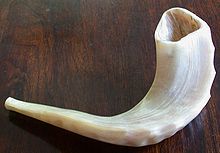
In Judaism, the High Holy Days, also known as High Holidays or Days of Awe (Yamim Noraim; Hebrew: יָמִים נוֹרָאִים, Yāmīm Nōrāʾīm) consist of:
- strictly, the holidays of Rosh Hashanah ("Jewish New Year") and Yom Kippur ("Day of Atonement");
- by extension, the period of ten days including those holidays, known also as the Ten Days of Repentance (עשרת ימי תשובה); or,
- by a further extension, the entire 40-day penitential period in the Jewish year from Rosh Chodesh Elul to Yom Kippur, traditionally taken to represent the forty days Moses spent on Mount Sinai before coming down with the second ("replacement") set of the Tablets of Stone.